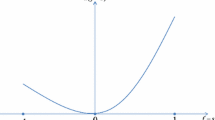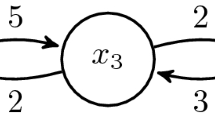Abstract
We study the problem of locating a single public good along a segment when agents have single-dipped preferences. We ask whether there are unanimous and strategy-proof rules for this model. The answer is positive and we characterize all such rules. We generalize our model to allow the set of alternatives to be unbounded. If the set of alternatives does not have a maximal and a minimal element, there is no meaningful notion of efficiency. However, we show that the range of every strategy-proof rule has a maximal and a minimal element. We then characterize all strategy-proof rules.





Similar content being viewed by others
Notes
This is a class of rules that generalizes voting by committeesBarberà et al. (1991) by allowing indifference between the two alternatives.
Single-dippedness of preferences can be generalized to more than one dimension in many ways. If the set of alternatives that can be top ranked under a permissible preference relation has more than two alternatives and its members can be ranked, relative to each other, in any way, we obtain the dictatorial results of Gibbard (1973) and Satterthwaite (1975). If we consider single-dipped preferences over a circle, they are also single-peaked, but lead to dictatorial results as well Schummer and Rakesh (2002).
Consider a majority voting rule. Let \(N\equiv \{1,2,3\}\) and \(R\in {\mathcal {R}}^N\) be such that \(N_0(R) = \{1\}, N_{0T}(R) = \{2\},\) and \(N_T(R) = \{3\}\). Let \(R_2'\in {\mathcal {R}}\) be such that \(T \mathrel {P_2'} 0\). Then \(T= M(R_2',R_{-2}) \mathrel P_3 M(R) = 0\). Thus, \(M\) is not strongly group strategy-proof.
In fact, any preference relation over \([0,T]\) such that the median is never the best among three distinct points is single-dipped. To see this, note that if the median is never best, then, at every point, the lower contour set is convex, and indifference is between no more than two distinct points. These are sufficient conditions for single-dippedness.
This is implied by Lemma 2 of Peremans and Storcken (1999), but we provide a simple direct proof.
References
Barberà S, Berga D, Moreno B (2010) Individual versus group strategy-proofness: when do they coincide? J Econ Theory 145(5):1648–1674
Barberà S, Berga D, Moreno B (2012a) Group strategy-proof social choice functions with binary ranges and arbitrary domains: characterization results. Int J Game Theory 41:791–808
Barberà S, Berga D, Moreno B (2012b) Domains, ranges and strategy-proofness: the case of single-dipped preferences. Soc Choice Welf 39:335–352
Barberà S, Sonnenschein H, Zhou L (1991) Voting by committees. Econometrica 59(3):595–609
Gibbard A (1973) Manipulation of voting schemes: a general result. Econometrica 41(4):587–601
Klaus B (2001) Coalitional strategy-proofness in economies with single-dipped preferences and the assignment of an indivisible object. Games Econ Behav 34:64–82
Klaus B, Peters H, Storcken T (1997) Strategy-proof division of a private good when preferences are single-dipped. Econ Lett 55:339–346
Larsson B, Svensson LG (2006) Strategy-proof voting on the full preference domain. Math Soc Sci 52(3):272–287
Le Breton M, Zaporozhets V (2009) On the equivalence of coalitional and individual strategy-proofness properties. Soc Choice Welf 33(2):287–309
Manjunath V (2012) Group strategy-proofness and voting between two alternatives. Math Soc Sci 63(3):239–242
Öztürk M, Peters H, Storcken T (2012a) On the location of public bads: strategy-proofness under two-dimensional single-dipped preferences, working paper. METEOR, Maastricht Research School of Economics of Technology and Organization, Maastricht
Öztürk M, Peters H, Storcken T (2012b) Strategy-proof location of a public bad on a disc, working paper. METEOR, Maastricht Research School of Economics of Technology and Organization, Maastricht
Peremans W, Storcken T (1999) Strategy-proofness on single-dipped preference domains. Proceedings of the International Conference, Logic, Game Theory and Social Choice, pp 296–313
Satterthwaite M (1975) Strategy-proofness and arrow’s conditions: existence and correspondence theorems for voting procedures and social welfare functions. J Econ Theory 10:187–217
Schummer J, Vohra RV (2002) Strategy-proof location on a network. J Econ Theory 104(2):405–428
Acknowledgments
I thank William Thomson, Dolors Berga, Bettina Klaus, participants at the SED 2008 Conference on Economic Design, the associate editor and two anonymous referees for their helpful comments and suggestions.
Author information
Authors and Affiliations
Corresponding author
Appendices
Appendices
1.1 The Pareto-set
The following lemmas pertain to the nature of the Pareto set.
Lemma 14
(Domination by extremes) For each \(R\in {\mathcal {R}}^N\) and each \(x \notin P(R)\), either \(0 \mathrel {\bar{P}} x\) or \(T \mathrel {\bar{P}} x\).
Proof
Let \(R\in {\mathcal {R}}^N\). If \(x\notin P(R)\), then there is \(y\in [0,T]\) such that \(y\mathrel {\bar{P}} x\). If \(x < y\), then \(y = \text {med}\{x,y,T\}\). Since \(y \mathrel {\bar{P}} x\), \(y \mathrel R_{N} x\). By single-dippedness of preferences, \(T \mathrel P_N y\). Therefore, \(T \mathrel {\bar{P}} x\).
If \(x > y\), an analogous argument shows that \(0 \mathrel {\bar{P}} x\). \(\square \)
Lemma 15
(Shape of the Pareto set) For each \(R\in {\mathcal {R}}^N\), \(P(R)\) has one of the following configurations:
-
1.
\(\{0\}\) if \(n_0(R) > 0\) and \(n_T(R) = 0\).
-
2.
\(\{T\}\) if \(n_0(R) = 0\) and \(n_T(R) > 0\).
-
3.
\(\{0,T\}\cup ({\underline{x}}(R), {\overline{x}}(R))\) if \(n_0(R) > 0\), \( n_T(R) > 0\), \({\underline{x}}(R) \in L(R_{{\underline{i}}(R)},0)\), \({\overline{x}}(R) \in L(R_{{\overline{I}}(R)},0)\), and \({\underline{x}}(R) < {\overline{x}} (R)\)
-
4.
\(\{0,T\}\cup [{\underline{x}}(R), {\overline{x}}(R))\) if \(n_0(R) > 0\), \( n_T(R) > 0\), \({\underline{x}}(R) \notin L(R_{\underline{i}(R)},0)\), \({\overline{x}}(R) \in L(R_{{\overline{I}}(R)},0)\), and \({\underline{x}}(R) < {\overline{x}} (R)\)
-
5.
\(\{0,T\}\cup [{\underline{x}}(R), {\overline{x}}(R)]\) if \(n_0(R) > 0\), \( n_T(R) > 0\), \({\underline{x}}(R) \notin L(R_{\underline{i}(R)},0)\), \({\overline{x}}(R) \notin L(R_{{\overline{I}}(R)},0)\), and \({\underline{x}}(R) < {\overline{x}} (R)\)
-
6.
\(\{0,T\}\cup ({\underline{x}}(R), {\overline{x}}(R)]\) if \(n_0(R) > 0\), \( n_T(R) > 0\), \({\underline{x}}(R) \in L(R_{{\underline{i}}(R)},0)\), \({\overline{x}}(R) \notin L(R_{{\overline{I}}(R)},0)\), and \(\underline{x}(R) < {\overline{x}} (R)\)
-
7.
\(\{0,T\}\) if \(n_0(R) > 0\), \( n_T(R) > 0\), and \(\underline{x}(R) > {\overline{x}} (R)\), or \(N_{0T} = N\).
See Fig. 6.
Proof
- Case 1: :
-
\(n_0(R) > 0, n_T(R) = 0\). For each \(x\in (0,T], 0 \mathrel {\bar{P}} x\). Thus, \(P(R) = \{0\}\).
- Case 2: :
-
\(n_T(R) > 0, n_0(R) = 0\). For each \(x\in [0,T), T \mathrel {\bar{P}} x\). Thus, \(P(R) = \{T\}\).
- Case 3: :
-
\(N_{0T} = N\). For each \(x\in (0,T)\), \( 0\mathrel {\bar{P}} x\) and \(0\mathrel I_N T\). Thus, \(P(R) = \{0,T\}\).
- Case 4: :
-
\(n_0(R) > 0, n_T(R) > 0\). By definition of \({\underline{i}}(R)\) and \({\overline{I}}(R)\), \(d_{{\underline{i}}(R)} \le {\underline{x}}(R)\) and \(d_{{\overline{I}}(R)} \le {\overline{x}}(R)\).
Step 1: For each \(y\in (0,{\underline{x}}(R))\), \(0 \mathrel {\bar{P}} y\). First, \(0 \mathrel P_{N_0(R)} T\). Thus, \(0 \mathrel P_{N_0(R)} y \equiv \text {med}\{0,y,T\}\). Second, \(0 \mathrel P_{N_{0T}(R)} y\). Finally, \(0 {\mathrel {R}}_{N_T(R)} y\). Suppose not. Then there is \(j\in N_T(R)\) such that \(y \mathrel P_j 0\). By definition \({\underline{x}}(R)= \displaystyle \min _{i\in N_T(R)}\{\max ({\overline{L}}(R_i, 0)\}.\) Thus, for each \(i \in N_T(R)\), \(y\in {\overline{L}}(R_i, 0)\). Thus for each \(i\in N_T(R)\), \(0 \mathrel P_i y\).
Step 2: For each \(y\in ({\overline{x}}(R), T)\), \(T \mathrel {\bar{P}} y\). The proof is analogous to that of Step 1.
Step 3: If \({\underline{x}}(R) < {\overline{x}}(R)\), then \(({\underline{x}}(R),{\overline{x}}(R))\subset P(R)\). Let \(y \in ({\underline{x}}(R),{\overline{x}}(R))\). Then \(y \mathrel P_{\overline{i}(R)} T\) and \( y \mathrel P_{{\underline{i}}(R)} 0\). Thus, neither \(0 \mathrel {\bar{P}} y\) nor \(T\mathrel {\bar{P}} y\). By domination by extremes, \(y\in P(R)\).
Step 4: \(\{0,T\} \subseteq P(R)\). For each \(i \in N_0(R),\) \(\tau ([0,T], R_i) = \{0\}\) and, for each \(j\in N_T(R), \tau ([0,T], R_j) = \{T\}\). Thus, \(\{0,T\} \subseteq P(R)\).
Step 5: If \({\underline{x}}(R) < {\overline{x}}(R)\), and \({\underline{x}}(R) \notin L(R_{{\underline{i}}(R)}, 0)\) then \(\underline{x}(R) \in P(R)\). Since \({\underline{x}}(R) \notin L(R_{\underline{i}(R)},0)\), \({\underline{x}}(R) \mathrel P_{{\underline{i}}(R)} 0\). Since \({\underline{x}}(R) < {\overline{x}}(R)\), \({\underline{x}}(R) \mathrel P_{{\overline{I}}(R)} T\). By domination by extremes, \(\underline{x}(R) \in P(R)\).
Step 6: If \({\underline{x}}(R) < {\overline{x}}(R)\), and \({\overline{x}}(R) \notin L(R_{{\overline{I}}(R)}, 0)\) then \(\overline{x}(R) \in P(R)\). The proof is analogous to that of Step 5. \(\square \)
Rights and permissions
About this article
Cite this article
Manjunath, V. Efficient and strategy-proof social choice when preferences are single-dipped. Int J Game Theory 43, 579–597 (2014). https://doi.org/10.1007/s00182-013-0396-4
Accepted:
Published:
Issue Date:
DOI: https://doi.org/10.1007/s00182-013-0396-4





